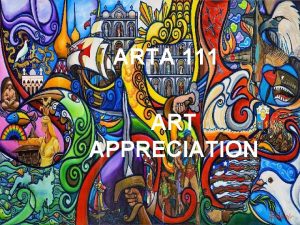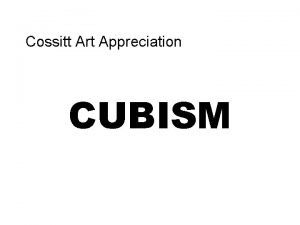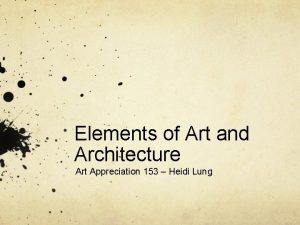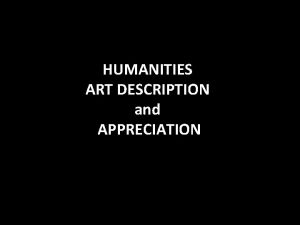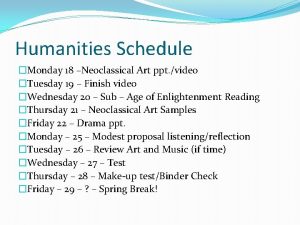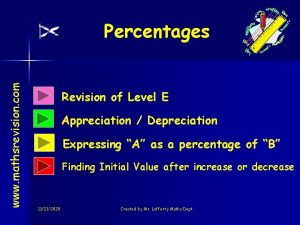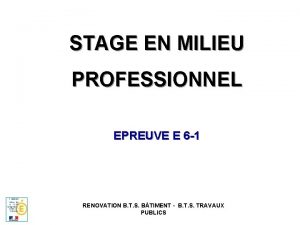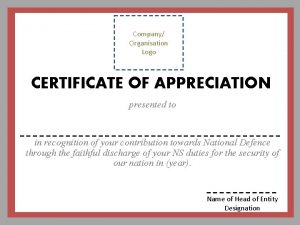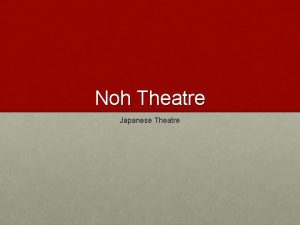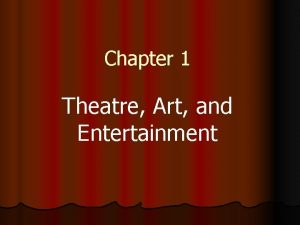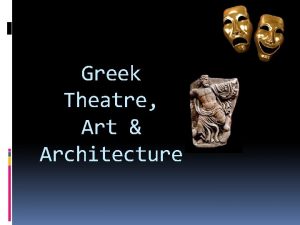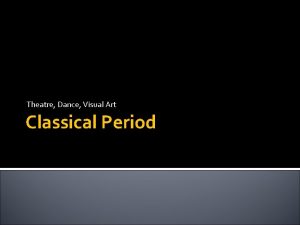Chapter 1 Theatre Art and Entertainment Art Appreciation































- Slides: 31

Chapter 1 Theatre, Art, and Entertainment

Art Appreciation? l http: //youtu. be/UM 21 g. Pmk. Dp. I




What is Art? l Prepare, l Prepare Share and Square - Write down your definition of art on a card or paper

What is Art? l Pair l Compare your definition with your neighbor and rewrite a definition of art to include both of your perspectives

What is Art? l Square l Compare you and your partner’s definition with another pair and rewrite to include everyone’s perspectives.

Share l Share class. your “squared” definitions with the

What were some common findings? Differences?

What is Art? l. A skill the Latin ars, l Greek word - technē l From l An act of beauty l From a branch of philosophy known as aesthetics l. A specific meaning l From an attempt to understand ourselves and the world around us

What is Art? “Art is a selective re-creation of reality according to an artist’s metaphysical value judgments. Man’s profound need for art lies in the fact that his cognitive faculty is conceptual, i. e. , that he acquires knowledge by means of abstractions, and needs the power to bring his widest meta-physical abstractions into his immediate perceptual awareness. ” Ayn Rand, author and philosopher

William Missouri Downs What are the basic qualities of art that all works of art share?

Art is a Form of Human Expression The word art springs from the same root as the word artificial. Art is not the real thing but rather a human creative endeavor that involves the perceptions and imagination of an artist who is trying to say something in his or her own particular way.

“In one sense the aim of Joseph Wood Krutch, author and philosopher William Missouri Downs the scientist and the aim of the artist are the same since both are in pursuit of what they call truth; but the difference between them may be said to consist in this, that while for science there is only one truth, for the artist there are many. ”

Art Involves Subject and Medium l Spatial Arts Architecture l Sculpture l l Pictorial Arts Painting l Line and color in two dimensions l l Literary Arts Poetry l Novels and short stories l l Performing Arts l Performed by a person

Art Makes You Feel Something Michael Falco/The New York Times/Redux Paul Drinkwater/NBCU Photo Bank via AP Images

Art Provides a Perception of Order “It is the function of all art to give us some perception of an order in life, by imposing order upon it. ” T. S. Eliot, poet “Life is very nice, but it lacks form. It’s the aim of art to give it some. ” Jean Anouilh, playwright

Michal Daniel/Proofsheet What is the Purpose of Art? “I am suspicious of any theory of art which says that art is just one thing and that it can be defined in a single aim, function, or purpose. ” Harold Taylor, art philosopher

What is Theatre? l The word theatre comes from the Greek word theatron meaning “seeing place. ” l “A man walks across this empty space whilst someone else is watching him, and this is all that is needed for act of theatre to be engaged. ” Peter Brook, The Empty Space

What is Drama? l The word drama comes from the Greek word dran meaning “to take action, to do, or to make” l Drama tells a story about people in conflict

Both Theatre and Drama Share Three Qualities l They are live – no two performances are the same l They are about human beings l They are collaborative art forms

Common Categories of Theatre

Commercial plays offer safe themes, plenty of laughs, and spectacle designed to appeal to a majority of people, thereby filling lots of seats and ideally making lots of money. William Missouri Downs 1. Commercial Theatre

Presents dramas that uses styles, themes, and staging of plays from a particular historical period. © 2000 Don Turner 2. Historical Theatre

Allows playwrights, directors, and actors to express their personal opinions about current issues, trends, and politics © P. Switzer 3. Political Theatre

Courtesy, Living Theatre 4. Experimental Theatre It might break down barriers by eliminating the distance between actor and audience, trying out new staging techniques, or even questioning the nature of theatre itself

5. Cultural Theatre Is designed to support the heritage, customs, and POV of a particular people, religion, class, country, or community. This theatre provides a window into a world that is different from their own or by preserving the unique traditions of a particular society.

Photo courtesy of Karen Berman Art and Entertainment “When you come into theater, you have to be willing to say, ‘We're all here to undergo a communion, to find out what the hell is going on in this world. ’ If you're not willing to say that, what you get is entertainment instead of art, and poor entertainment at that. David Mamet, Three Uses of the Knife

Art and Entertainment l l l l Lets us see another’s POV Requires active viewing Is about self-examination Has great potential as an agent of social change Challenges the audience Is about edification, transcendence, contemplation Does not compromise for public taste l l l Reaffirms our own POV Is directed toward the largest possible number Makes no intellectual demands on the viewer May examine life but does not lead to criticism Has little potential as an agent of social change Is about gratification, indulgence, escape

Curtain Call We need art and theatre because they help us see life differently. Entertainment allows us to see life as we see it, with our values and perceptions intact. Art, on the other hand, allows us to expand our experience, intensify our perceptions, challenge conventional wisdom, and introduce another frame of reference—that of the artist.
 Drama in art appreciation
Drama in art appreciation Art appreciation subject
Art appreciation subject 4 steps in art appreciation
4 steps in art appreciation Rhythm music appreciation
Rhythm music appreciation What is cubism in art appreciation
What is cubism in art appreciation Brancusi
Brancusi Architecture in art appreciation
Architecture in art appreciation Description
Description Art discussion questions
Art discussion questions Humanities art appreciation ppt
Humanities art appreciation ppt Accel entertainment jobs
Accel entertainment jobs Chapter 7 sports and entertainment marketing
Chapter 7 sports and entertainment marketing Chapter 7 sports and entertainment marketing
Chapter 7 sports and entertainment marketing Sports and entertainment marketing 1
Sports and entertainment marketing 1 Chapter 2 sports and entertainment marketing
Chapter 2 sports and entertainment marketing Chapter 7 lesson 3 help for families
Chapter 7 lesson 3 help for families Convergence mktg
Convergence mktg Entertainment means
Entertainment means Chapter 7 sports and entertainment marketing
Chapter 7 sports and entertainment marketing Appreciation and depreciation of currency
Appreciation and depreciation of currency Appreciation and depreciation maths
Appreciation and depreciation maths Exemple appréciation stagiaire
Exemple appréciation stagiaire Share appreciation rights
Share appreciation rights Perguisite
Perguisite Diversity appreciation
Diversity appreciation Peason
Peason Appreciation of the currency
Appreciation of the currency Hereby awards
Hereby awards Exemple d'appréciation livret scolaire maternelle
Exemple d'appréciation livret scolaire maternelle Certificate of contribution
Certificate of contribution Inurl:bug bounty intext:token of appreciation
Inurl:bug bounty intext:token of appreciation Circle of gratitude meaning
Circle of gratitude meaning

